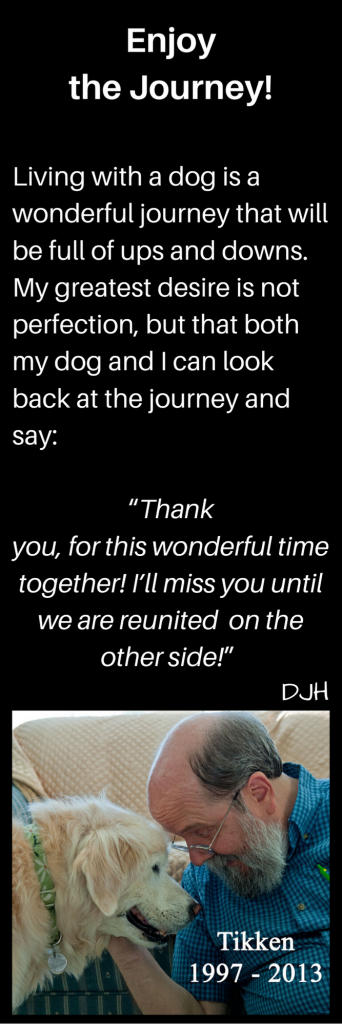< This article was originally published in three parts in the February, March & May 2020 issues of Downeast Dog News >
< Updated 11MAY20 >
< A short link for this page – http://bit.ly/SearchingForThePerfectDog >
What Can Affect Our Dogs Behavior?
I am often asked, “How do I get the perfect dog.” I always start by asking for clarification of how the person that asked the question defines “perfect.” Typical responses are;
I want a dog that will:
- have good manners,

- NEVER bite,
- NEVER growl,
- like ALL people,
- like ALL dogs,
- like ALL of our current pets,
- will NEVER chase cars,
- will ALWAYS stay in an unfenced yard,
- will NEVER jump on people,
- will ALWAYS alert me when someone “sketchy” is in the yard but will NEVER bark at people I like,
- will NEVER kill a squirrel,
- will ALWAYS be safe around ALL kids,
- will ALWAYS come when called and
- will stay close to me but will not hang around me when I don’t want them to,
- and so on.
At its most extreme, that sounds like “I want a dog that will do anything I want, whenever I want, and will do nothing and be content if I don’t want them to do anything.” That is not a realistic expectation and is failing to meet some of our dog’s most basic welfare requirements. [ FMI – http://bit.ly/Brambells-1-5 ]
I often wonder where people get their expectations of what constitutes a “perfect” dog. Unfortunately, not all but some of the people selling dogs, breeders, shelters/rescues, pet shops, set us up to think the dog they want us to go home with is “perfect” because they know if we think otherwise, they may lose a sale. Selling a dog is not unlike most other things for sale. We typically want the best we can get. In some cases, those selling the dog even go so far as to use puppy temperament tests and shelter behavior assessments to convince us this is the right dog for us. Unfortunately, these tests may be misrepresented and presented to us as a predictor of future behavior. If we interpret that as a guarantee, they may or may not try to dissuade us from that impression. Temperament and shelter assessment tests are nothing more than a snapshot of a dog’s behavior in a specific scenario at a single moment in time. They are not predictive of nor are they a guarantee of future “perfect” behavior.
In some cases, our expectations of a “perfect” are the result of memories of dogs popularized through the mass media like Lassie or Air Bud. As endearing as those stories are, they are fictional accounts of dogs. Assumptions about certain breeds, usually based on an opinion that may not be supported by data, such as “Schnockelfensters are ALWAYS great with children!” can also bias our opinion inappropriately. I cannot tell you how many different individual dogs and breeds I have met over the past 25 years, but I do know I have seen extremes in behavior in all breeds.
If we look at the list of the characteristics many want in a “perfect” dog, most of those characteristics focus on a dog’s behavior, what it will or will not do. I also want to point out that people often also use lots of absolutes with words like; ‘NEVER,’ ‘ALWAYS,’ and ‘ALL.’ The problem with using absolutes when discussing the behavior of a dog, or any animal, even human behavior, is that behavior can change and often does change and, like most of life, is seldom absolute. [ FMI – http://bit.ly/AnimalWelfare-Behavior ]
Many things can affect behavior. Genetics play a major role in future behavior. If either parent had certain genetic traits such as shyness, the puppies will probably also be shy.
We have many different breeds of dogs because they were selectively bred for certain traits. Dogs come preprogrammed with certain species-specific behavior motor patterns based on what they were bred to do. The dog is a predator, and as such has a motor pattern sequence to ORIENT > EYE > STALK > CHASE > GRAB-BITE > KILL-BITE > DISSECT > CONSUME prey. That does not mean every dog will be an efficient predator, but they may still have a strong instinct to go through all or part of this sequence. This pattern of behaviors is what makes retrievers retrieve and what allows herding breeds to move livestock successfully. Unfortunately, a working herding dog with strong instincts to stalk, chase, and grab-bite is probably not a desirable trait for a dog that will be living with children. Something we need to consider when searching for the “perfect” dog for our family today and what it will look like throughout the dog’s expected life. A herding breed may be a perfect companion for a young couple that likes to hike, but may not be the best choice if two years later they have twin infants. [ FMI – http://bit.ly/DoesDogBreedMatter ]
What happens during a puppy’s critical developmental period from birth to 16 weeks of age also has a great influence on behavior. If a puppy is a singleton, that puppy not have an opportunity to experience social interactions with littermates unless it is placed in another litter where it can gain the social skills it will need to interact with other dogs successfully. [ FMI – http://bit.ly/SocializationPuppy ]
What Can Affect Our Dogs Behavior? (part 2)
Once a dog leaves mom and its littermates, and it arrives in our home, we are responsible for that puppy and need to appropriately socialize and habituate it to everything we expect it to encounter (people, animals, surfaces, objects, sounds, smells, etc.) before they are 16 weeks old. Socialization can be a very daunting and time-consuming task if you do it right, but it is essential for your dog’s future behavioral health. A puppy that is not gently exposed to a wide variety of people of different ages, sizes, races, and behaviors may very likely be fearful of certain types of people. Never being brushed or having their nails trimmed until after 16 weeks of age may result in a dog that is extremely fearful and reactive during this process, which can be a stressful experience for all involved. A puppy that is raised in a rural area the first 16 weeks of its life and then moved to a home in an urban environment with the never before experienced sounds, smells, and intense activity of urban America, may become very anxious and fearful. A dog that is displaced from its home and family could be extremely traumatized just as you might be in shock if you ended up living in a homeless shelter. Trauma can cause fear and anxiety for life and does not go away on its own.
Whether you decide to train your dog and how you train them will also affect future behavior. Dogs with little or no training are less likely to be well-mannered and, for that reason, are more likely to be surrendered. If you use any aversives to train your dog, the most common ones being shock, choke, or prong collars, your dog is more likely to develop behavioral problems. If you inadvertently reward your dog for jumping up on people, chasing people, or barking at strangers, you may create the very behavior problems you are trying to prevent. Training matters and you will be best served by investing in working with a reward-based dog trainer accredited by a reputable, independent certification body.
During the course of your dog’s life, they will have many behavioral interactions with people and animals. Any time such an interaction occurs, the behavior of one individual in the interaction can influence the behavior of the other individual. The simple act of an infant grabbing at a dog’s wagging tail, due to no malicious intent, may cause the dog to feel physical or emotional pain or discomfort causing the dog to react with anything from a bark to a bite in an attempt to get the child to stop their behavior. The infant’s behavior may have established a fear of children, and the dog and the dog’s reaction may have created a fear of dogs in the child. Fears of this nature can be locked into memory by a single event, and the brain is designed, in the interest of our survival, to remember these lessons forever.
Many behaviors in all animals are driven by emotion and thus are not always predictable or rational. Either party in a behavioral transaction can misinterpret the behavior of the other, which can cause a situation to spiral out of control quickly. It’s dark, and you cannot see your dog lying by the bed, you get up and step on the dog, and the dog lashes out in fear biting your ankle but not breaking the skin, you scream in pain and yell at the dog as you kick him, causing your dog to bite harder in an attempt to get you to stop before he scrambles under the bed to hide from the vicious person. You have both reacted instinctually and emotionally and may be wary of one another for minutes, hours, days, or maybe forever. Emotional responses have a great impact on our reactions to another’s behavior and on our remembering those incidents.
How Can We Optimize Our Odds of Getting The “Perfect” Dog
A variety of medical issues that can affect behavior. Behavior problems can begin before birth if mom is unhealthy or stressed. The endocrine system which produces hormones can negatively affect behavior when it is not working properly, such as with thyroid and adrenal issues. Neurological, orthopedic, and even gastrointestinal disorders, or any medical issue that causes pain or discomfort can also cause our dog to behave differently. Even an adverse reaction to a vaccination may cause an undesirable behavior change. The simple act of aging can change behavior as hearing and sight diminish or cognitive disorders manifest themselves. At the first sign of a behavior problem with your dog, talk about it with your veterinarian. Do not wait a week, a month, or years. Your dog’s life and your safety, and that of others may depend on it. Also, understand that the longer an undesirable behavior occurs, the less likely we can change it.
What can we do to optimize our odds of getting a “perfect” dog?
Do your research – Before you even start looking for a dog, thoughtfully consider what you want and expect in a dog. Not all dogs behave the same way due to selective breeding for certain behavioral traits. Some may express behaviors that are normal but that we may not want to deal with, such as herding dogs around children. When I counsel someone looking for a dog, I focus on behavior and health. What a dog looks like is a low priority for me. When doing your research, talk to pet care professionals with experience with the behavior of many breeds; trainers, behavior consultants, and veterinarians will be your best option. Professionals are more likely to give you an objective opinion than a breeder or rescue that wants you to take their dog home. Be aware that if you are considering a rescue dog, they are likely to be a mixed-breed, and the odds of knowing the precise mix of breeds are incredibly small without a DNA test. Even if we know a mixed breeds genetic profile, predicting behavior can be difficult, if not impossible.
NOTE: I have nothing against rescue dogs or mixed breeds. Seven of my nine dogs were rescues. My objective is to suggest what you can do that gives you the highest probability of getting the dog that meets your definition of “perfect.” Sadly, we seldom get all of the information we need about a  rescue to make a reliable prediction of future behavior. I believe that you will have the best chance of getting the dog you want by getting a puppy of a known DNA lineage, from a reputable breeder.
rescue to make a reliable prediction of future behavior. I believe that you will have the best chance of getting the dog you want by getting a puppy of a known DNA lineage, from a reputable breeder.
See your dog’s parents – Genetics cannot be changed so the best way to prevent your dog’s DNA from negatively affecting your concept of “perfect” is for you to make sure that you get to see your dog’s parents so you can observe their behavior. If you notice any behavior of concern, look elsewhere.
Immediately work with a force-free professional trainer – Before you bring your puppy or dog home, select a trainer. They can help you meet your puppy’s socialization needs between 8 and 16 weeks of age. This is a critical period for learning and habituation, and it ends quickly. Most of the dogs brought to me for fear and aggression were not adequately or appropriately socialized. A professional can also help you with the most common puppy problem behaviors such as play-biting, housetraining, jumping up on people, and chewing. Most people unintentionally train the puppy to do what they don’t want. A professional will teach you what and how to reward behavior so the dog does what you want.
Continue working with a trainer who will teach you how to most effectively and humanely train your dog until you and your dog have mastered the behaviors that are important to the success of your relationship.
Be patient and accepting with yourself and your dog – You are only human, and like all other humans, you’re not “perfect,” and neither is your dog. While I understand the desire to have a “perfect” dog, and I believe it is a noble goal, at its best, it is nothing more than a hypothetical construct.
We will only know if we have had a “perfect” dog when they pass, and we can look back on their life and say, “My dog was perfect.” I have enjoyed and benefited from every dog in my life. Almost everyone had some characteristics that might be classified as “perfect,” but each also had some quirks. Those flaws or quirks made them the amazing individual I will never forget.
Recommended Resources
Brambell’s Five Freedoms – Helping Your Dog Thrive – http://bit.ly/Brambells-1-5
Understanding Behavior; Why It Matters – http://bit.ly/AnimalWelfare-Behavior
Does My Dogs Breed Matter? – Parts 1, 2 & 3 – http://bit.ly/DoesDogBreedMatter
Puppy Socialization and Habituation – http://bit.ly/SocializationPuppy
Adopting A Pet – Finding the Right Dog for You and Your Family – http://bit.ly/FindingTheRightDogForYou
Adopting A Pet – We’re Getting A New Puppy (or Dog)! – http://bit.ly/GettingNewPuppyDog
________________________________________________________________________
Don Hanson is the co-owner of the Green Acres Kennel Shop ( greenacreskennel.com ) in Bangor, ME where he has been helping people with their pets since 1995. He is a Bach Foundation Registered Animal Practitioner (BFRAP), Certified Dog Behavior Consultant (CDBC), Associate Certified Cat Behavior Consultant (ACCBC) and a Certified Professional Dog Trainer (CPDT-KA). Don is a member of the Pet Professional Guild (PPG) and is committed to PPG’s Guiding Principles and the Pain-Free, Force-Free, and Fear-Free training, management, and care of all pets. Don produces and co-hosts a weekly radio show and podcast, The Woof Meow Show, that airs on Z62 Retro Radio WZON (AM620) and WKIT 103.3-HD3 and is streamed at http://bit.ly/AM620-WZON every Saturday at 9 AM. Podcasts of the show are available at http://woofmeowshow.libsyn.com/, the Apple Podcast app, and at Don’s blog: www.words-woofs-meows.com. The opinions in this post are those of Don Hanson.
©11MAY20, Donald J. Hanson, All Rights Reserved
< Click for Copyright and Use Policy >
 while creating a positive association.
while creating a positive association.
 Podcasts from The Woof Meow Show
Podcasts from The Woof Meow Show







